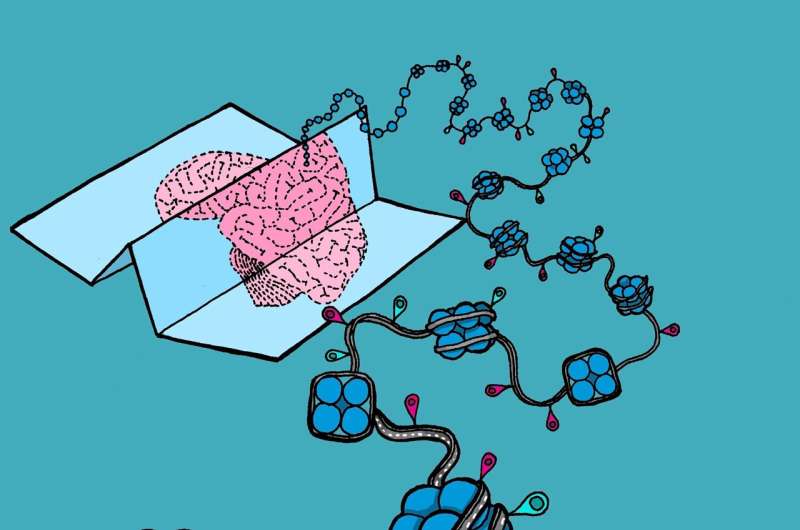This article has been reviewed according to Science X's editorial process and policies. Editors have highlighted the following attributes while ensuring the content's credibility:
fact-checked
peer-reviewed publication
trusted source
proofread
Two studies offer key insights into the origins and potential treatment of mental health disorders

Working under the umbrella of the PsychENCODE Consortium, the mental health research project established in 2015 by the National Institutes of Health, a team of Mount Sinai scientists has uncovered important new insights into the molecular biology of neuropsychiatric disease through two new studies published in a special issue of Science on May 24.
These investigations, conducted with colleagues from other major research centers, involve the largest single-cell analysis to date of the brains of people with schizophrenia, and a first-of-its-kind population-scale map of the regulatory components of the brain that provides critical insights into the pathogenesis of mental health disorders.
"We desperately need new directions for developing treatments for individuals with schizophrenia and other serious mental health illnesses," says Panos Roussos, MD, Ph.D., senior author of both studies; Professor of Psychiatry, and Genetics and Genomic Sciences, at the Icahn School of Medicine at Mount Sinai; and Director of the Center for Disease Neurogenomics.
"We now have the technology and methodology to do a deeper dive than ever before into the biology of neuropsychiatric diseases, and believe that through our latest research we have significantly advanced the field."
Since the launch of PsychENCODE, dozens of scientists from Mount Sinai along with colleagues from 14 other research institutions have identified several hundred new risk genes for mental disorders that include schizophrenia, autism spectrum disorder, and bipolar disorder. That body of work has also revealed critical time windows during brain development when these genes can most influence the disease process.
Findings from the first phase of PsychENCODE were published in Science in 2018. These studies were based largely on molecular data collected from previous work. The newest investigations break fresh scientific ground, as evidenced by the following two papers in Science led by Mount Sinai.
Single-cell analysis of schizophrenia brains
Using a high-resolution dataset of 468,000 single-cell transcriptomes from 140 individuals, researchers looked for cell type-specific schizophrenia-dysregulated genes, pathways, and regulators. The result was a more comprehensive and highly detailed understanding of the molecular alterations associated with schizophrenia—in effect, a reframing of schizophrenia transcriptional pathology.
"While we observed gene change expression within all detected cell types, the majority occurred in neuronal populations and, specifically, more than three-quarters in excitatory neurons, which constitute the bulk of the brain's neurons," says Dr. Roussos, who led the analysis with John Fullard, Ph.D., Assistant Professor of Psychiatry, and Genetics and Genomic Sciences, at Icahn Mount Sinai.
The collaboration included partners from the Eli and Edythe L. Broad Institute of the Massachusetts Institute of Technology and Harvard, which allowed the team to compare independent findings from different patient cohorts to verify their consistency from one dataset to another.
"After pinpointing the molecular changes, we were able to look one level up to identify the transcription factors that drive many of those alterations," explains Dr. Fullard. "That allowed us to identify important upstream regulators that could serve as targets for drug development."
Regulatory mechanisms underlying brain disease
This study of samples from the brains of individuals with and without neuropsychiatric diseases generated the largest epigenetic analysis to date of the human brain. That, in turn, led to a population-scale map of the regulatory components of the brain and their potential linkage to mental health conditions.
"We can now begin to understand how genetic variation among individuals might affect epigenetic regulation," says Biao Zeng, Ph.D., Instructor of Psychiatry, and Genetics and Genomic Sciences, at Icahn Mount Sinai and lead author of the study.
"As the field of gene therapy continues to progress, the linkage of risk loci for a wide range of psychiatric and neurological disorders with human brain regulatory regions holds great promise for therapeutic applications."
Notably, Dr. Zeng adds, genome editing technologies such as CRISPR can potentially target regulatory elements and modify their activity, potentially restoring regulatory mechanisms to a pre-disease state. "The combination of population-scale regulome studies and advances in gene regulation," he notes, "will undoubtedly provide important new avenues for treating brain disorders in the future."
Mount Sinai entities involved in the PsychENCODE Consortium include The Friedman Brain Institute, the Seaver Autism Center for Research and Treatment, the Department of Psychiatry, The Mindich Child Health and Development Institute, the Department of Genetics and Genomic Sciences, the Nash Family Department of Neuroscience, and the Icahn Institute for Data Science and Genomic Technology.
More information: W. Brad Ruzicka et al, Single-cell multi-cohort dissection of the schizophrenia transcriptome, Science (2024). DOI: 10.1126/science.adg5136. www.science.org/doi/10.1126/science.adg5136
Special issue collection: www.science.org/collections/psychencode2




















